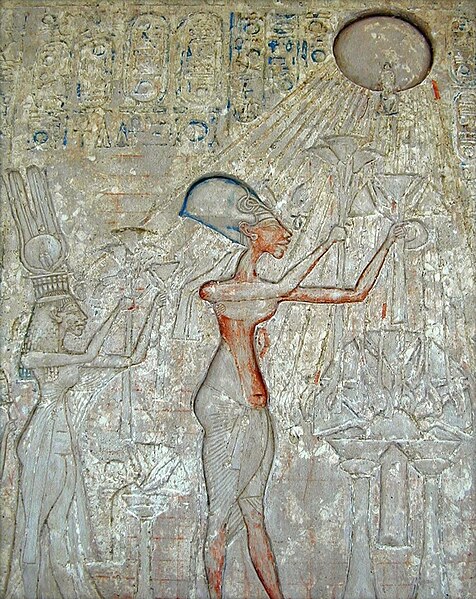Aten also Aton, Atonu, or Itn was the focus of Atenism, the religious system formally established in ancient Egypt by the late Eighteenth Dynasty pharaoh Akhenaten. Exact dating for the 18th dynasty is contested, though a general date range places the dynasty in the years 1550 to 1292 B.C.E. The worship of Aten and the coinciding rule of Akhenaten are major identifying characteristics of a period within the 18th dynasty referred to as the Amarna Period.
The "Great Hymn to the Aten" written from Akhenaten's point of view; the authorship of the hymn is disputed. Found in the tomb of Ay at Amarna. New Kingdom, Late 18th Dynasty. Amarna, Egypt.
Relief depicting Akhenaten and Nefertiti with three of their daughters under the rays of Aten.
Inscription from the Royal Tomb of Amarna depicting Akhenaten, Nefertiti, and two of their daughters (obscured) worshipping, or 'adoring', the Aten. New Kingdom, late 18th Dynasty. Amarna, Egypt. The Egyptian Museum, Cairo.
Akhenaten sacrificing a duck. New Kingdom, late 18th Dynasty. The Metropolitan Museum of Art, New York City.
Atenism, also known as the Aten religion, the Amarna religion, and the Amarna heresy, was a religion in ancient Egypt. It was founded by Akhenaten, a pharaoh who ruled the New Kingdom under the Eighteenth Dynasty. The religion is described as monotheistic or monolatristic, although some Egyptologists argue that it was actually henotheistic. Atenism was centred on the cult of Aten, a god depicted as the disc of the Sun. Aten was originally an aspect of Ra, Egypt's traditional solar deity, though he was later asserted by Akhenaten as being the superior of all deities. In the 14th century BC, Atenism was Egypt's state religion for around 20 years, and Akhenaten met the worship of other gods with persecution; he closed many traditional temples, instead commissioning the construction of Atenist temples, and also suppressed religious traditionalists. However, subsequent pharaohs toppled the movement in the aftermath of Akhenaten's death, thereby restoring Egyptian civilization's traditional polytheistic religion. Large-scale efforts were then undertaken to remove from Egypt and Egyptian records any presence or mention of Akhenaten, Atenist temples, and assertions of a uniquely supreme god.

Limestone relief at Amarna depicting Akhenaten, Nefertiti, and their children adoring Aten, c. 1372–1355 BC
The name of god Amun was erased, probably during the Amarna era of Akhenaten. Detail of stela of Djeserka, a doorkeeper of the Amun temple at Thebes. From Thebes, Egypt. The Petrie Museum of Egyptian Archaeology, London
Hieroglyphs on the backpillar of Amenhotep III's statue. There are 2 places where Akhenaten's agents erased the name Amun, later restored on a deeper surface. The British Museum, London
Detail of funerary stela of Amenemhat. The name of God Amun was erased by Akhenaten's agents. Limestone, painted. From Egypt, early 18th Dynasty. The Burrell Collection, Glasgow







